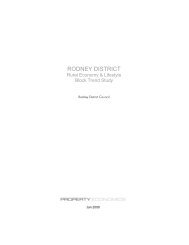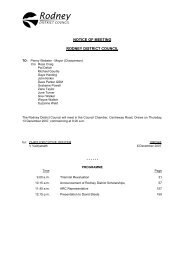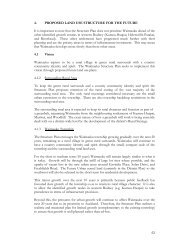RESOURCE CONSENTS HEARINGS PANEL - Auckland Council
RESOURCE CONSENTS HEARINGS PANEL - Auckland Council
RESOURCE CONSENTS HEARINGS PANEL - Auckland Council
You also want an ePaper? Increase the reach of your titles
YUMPU automatically turns print PDFs into web optimized ePapers that Google loves.
16<br />
28 November 2008<br />
Resource Consents Hearings Panel<br />
Minutes<br />
EFFECTS ON THE ENVIRONMENT<br />
Having considered the evidence of Ms Gardner and Mr Parfitt and having carried out a careful<br />
inspection during the site visit, the Panel is satisfied that any potential adverse effects arising from the<br />
intensity of vehicle movements will be satisfactorily avoided, remedied or mitigated. We note that the<br />
intersection upgrading proposed by the applicant will provide benefits to all of the residents in Tapu<br />
Road who use the intersection and that in itself provides a form of offset mitigation. We note that the<br />
frontage of Tapu Road that will be impacted by vehicles visiting the site is limited to a relatively short<br />
distance affecting only the properties at 6 and 8 Tapu Road. We find that the evidence of Ms<br />
Gardner, Mr Parfitt and Ms Peake established that the bulk of the development and its placement on<br />
the site would not have any effects on landscape or visual amenities that are more than minor. We<br />
are satisfied that the intensity of human activity generated by the proposed commercial activities on<br />
the site, would not have more than minor adverse effects on neighbouring properties because it is<br />
focused away from nearby residential dwellings.<br />
THE OBJECTIVES AND POLICIES OF THE DISTRICT PLANS.<br />
The evidence of Ms Gardner and Mr Parfitt established that both of the District Plans made provision<br />
for non-residential activities to take place within residential zones. We note that the ODP (under<br />
3H(2)(d)(iv) ) emphasises that the control of non-residential activities within residential zones is to be<br />
defined on the basis of limiting the range of effects and protecting residential amenity. Similarly Policy<br />
8.4.5 of the PDP provides that non-residential activities are to be controlled on the basis of limiting the<br />
extent of adverse effects so as to ensure that such effects are not incompatible with the environment<br />
of residential areas. Having considered these matters we are satisfied that the proposed development<br />
would not be significantly incompatible with the amenities of this residential area and any adverse<br />
effects on the amenity of adjacent residential properties would be satisfactorily avoided, remedied or<br />
mitigated. On this basis we do not consider that the grant of consent to the application would be<br />
contrary to the objectives and policies of the District Plans.<br />
THE INTEGRITY OF THE DISTRICT PLANS<br />
Both Ms Gardner and Mr Parfitt were of the view that the site, including its context within the<br />
immediate neighbourhood, had unusual characteristics which together made it less suitable for<br />
residential development and unlikely to be used for residential purposes in the foreseeable future. We<br />
agree with those assessments and accept that the site would be more appropriately developed for the<br />
purposes proposed rather than maintained in its current state provided that:<br />
- the development is constructed in accordance with the applicant’s intention of providing a<br />
quality development reflecting sustainable development principles;<br />
- the development continues to be based on an architectural style that would reflect and<br />
have appropriate regard to significant local rural characteristics.<br />
We do not consider that the alternative approach of refusing consent, in the hope that the site might<br />
eventually be used for some residential activities, is justified in these circumstances. We particularly<br />
rely on the evidence of Mr Trevelyan in regard to the assessment of the quality of the proposed<br />
development. We were also satisfied that the residential development further to the east on this side<br />
of State Highway 16 presented a more consistent residential neighbourhood pattern with a further<br />
benefit of a slip road providing separation of the frontage of these properties from the State Highway<br />
and vegetative screening at the edge of the Highway. Consequently we consider that the grant of<br />
consent to this application would have sufficient distinguishing characteristics to avoid the creation of<br />
a precedent for other similar development in the medium intensity residential area of Huapai.<br />
POTENTIAL EFFECTS ON THE VIABILITY OF THE HUAPAI RETAIL CENTRE<br />
Consideration of the potential effect of the establishment of retail activities at the site, and on the<br />
viability of the main Retail Centre at Huapai (as a consequence on the ability of that centre to continue<br />
to serve the needs of the community) is not able to be assessed directly. Rather it is a question of the<br />
probability of effects that might arise. Accordingly the question the Panel had to consider was whether<br />
the level of risk was high or low, and whether the effects would have a high or low impact. We<br />
considered that the risk of an effect on the Huapai Retail Centre such as to significantly affect its






